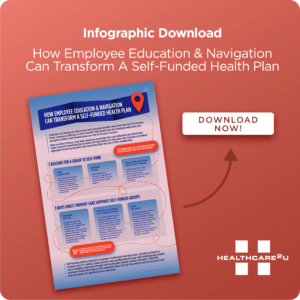Blog Posts
Health Benefits Education and Direct Primary Care Can Lower Costs for Self-Funded Groups
Self-funded plans are a great way to offer customizable benefits that employees want and need while lowering healthcare costs. Most brokers agree that self-funding is in the best interest of their larger clients’ long-term strategies. However, 52 percent said their fully insured clients remain fully insured because of the perception there is too much risk in self-funding. This perceived risk stems from misunderstanding the self-funded strategy and stop-loss protection.
A well-run self-funded health plan — that operates at the most efficient level and maximizes cost savings — requires buy-in from executive leadership, who understand the importance of expense management, employee education, continuous communication, and a preventive health strategy. By using claims data to create a unique benefits plan and educating employee populations about their personal health and employer-sponsored coverage, employers can shield the self-funded plan from costly claims and result in better health outcomes for their workforce.
The cost of preventable health conditions on a self-funded plan
As we continue to see healthcare costs increase, employers are relying on benefit advisors to help manage their expenses. Before deciding on a cost containment strategy for clients, it’s essential to understand the cost of preventable health conditions and employee claims data.
Preventable chronic conditions are a significant contributor to the costs of health insurance premiums and employee medical claims. Four of the costliest health conditions (and one-third of all deaths) are related to heart disease and stroke. These conditions cost our healthcare system $216 billion annually and cause $147 billion in lost productivity on the job. However, these conditions don’t materialize overnight and often result from years of poor health.
Since most costly health conditions are preventable, brokers should pair self-funded plans with preventative care services. One of the significant advantages of self-funded plans is that employers have the claims data to make informed decisions and the flexibility to combine and remove services that address the unique needs of their employees. However, preventative care and chronic disease related claims can slowly chip away at claims reserves, leaving little for more significant claims or enough to roll over into the following year. Including a product like Direct Primary Care (DPC), which provides unlimited primary care visits for a flat monthly fee, can help shield reserves from an entire category of claims by absorbing the costs of routine preventative care. This type of membership can also help employees who are dealing with a chronic disease by providing affordable visits and encouraging them to actively manage their health. By deflecting claims for preventative care and chronic disease management, plan costs are significantly lowered.
Disconnect in benefit offerings and understanding
Brokers can help their clients create a perfect benefits plan. Still, the plan won’t deliver the desired results if the employees don’t understand the benefits terminology, how to access and utilize their benefits, or how their benefits impact their health.
A survey conducted by LIMRA found that 53 percent of employees felt that their employer didn’t communicate their medical benefits well. This lack of understanding can result in the underutilization or misuse of benefits and frustration from employees. Brokers should encourage their clients to continuously communicate their benefit offerings throughout the year, using several channels to reach all employees. Communications should cater to each employee cohort and highlight what matters most to them. Usage examples can also help employees determine which benefits to use for specific situations.
In addition to benefits education, employees need to understand how their benefits impact their overall health, present and future. Multiple studies have confirmed that regular primary care visits result in better health over the long term, but few people go to regular visits. OnlineDoctor.com found that 1/3 of Americans avoid regular doctor appointments, citing insurance coverage and costs as a primary reason. Employers can address this issue by highlighting the costs of commonly used benefits and incentivizing employees to visit their Primary Care Provider (PCP). Beyond the doctor’s office, educational materials regarding chronic conditions and prevention should also be included in regular communications throughout the year, such as a monthly email campaign to employees.
In our next blog post, we will briefly discuss how employee benefits education is beneficial and critical to a self-funded health plan. Read further here.
Blog Posts
News
Uncategorized
Blog Posts
News
Blog Posts
Blog Posts
News
Blog Posts
Blog Posts
Blog Posts
Blog Posts
Blog Posts
Blog Posts
Blog Posts
Blog Posts
Blog Posts
Blog Posts
Blog Posts
Blog Posts
Blog Posts
Blog Posts
Blog Posts
Blog Posts
Blog Posts
Blog Posts
Blog Posts
Blog Posts
Blog Posts
Blog Posts
Blog Posts
Blog Posts
Blog Posts
Blog Posts
Blog Posts
Blog Posts
Blog Posts
Blog Posts
Blog Posts
Blog Posts
Blog Posts
Blog Posts
Blog Posts
Blog Posts
Blog Posts
Blog Posts
Blog Posts
Blog Posts
Blog Posts
Blog Posts
Blog Posts
Blog Posts
Blog Posts
Blog Posts
Blog Posts
Blog Posts
Blog Posts
Blog Posts
Blog Posts
Blog Posts
Blog Posts
Blog Posts
Blog Posts
Blog Posts
Blog Posts
Blog Posts
Blog Posts
Blog Posts
Blog Posts
Blog Posts
Blog Posts
Blog Posts
Blog Posts
Blog Posts
Blog Posts
Blog Posts
Blog Posts
Blog Posts
Blog Posts
Blog Posts
Blog Posts
Blog Posts
Blog Posts
Blog Posts
Blog Posts
Blog Posts
Blog Posts
Blog Posts
Blog Posts
Blog Posts
Blog Posts
Blog Posts
Blog Posts
Blog Posts
Blog Posts
Blog Posts
Blog Posts
Blog Posts
Blog Posts
Blog Posts
Blog Posts
Blog Posts
Blog Posts
Blog Posts
Blog Posts
Blog Posts
Blog Posts
Blog Posts
Blog Posts
Blog Posts
Blog Posts
Blog Posts
Blog Posts
Blog Posts
Blog Posts
Blog Posts
Blog Posts
Blog Posts
Blog Posts
Blog Posts
Blog Posts
Blog Posts
Blog Posts
Blog Posts
Blog Posts
CONTACT US
BECOME A PART OF THE SOLUTION
Redefine the healthcare experience with No-Claims Healthcare™
